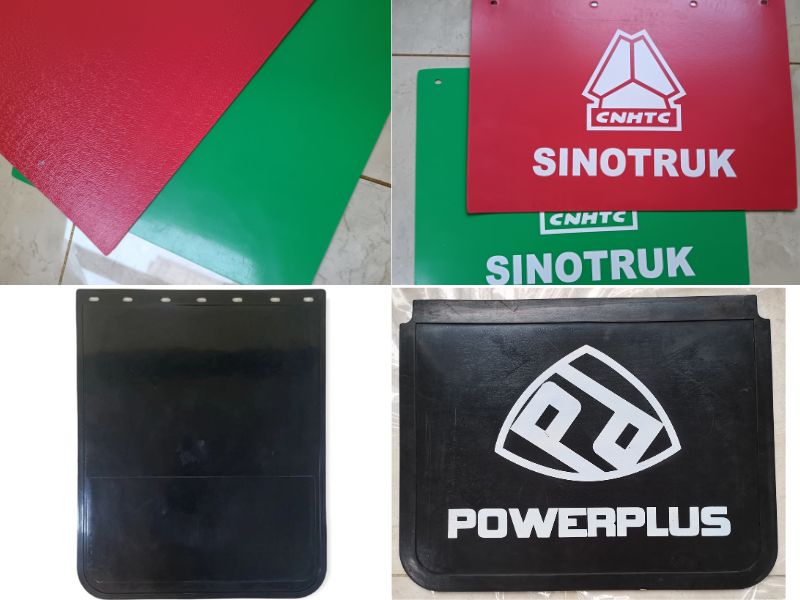
Mudflaps are an essential component for vehicles, protecting both the car and other road users from debris, dirt, and water kicked up by the tires. Two of the most common materials used for mudflaps are rubber and PVC (polyvinyl chloride). While both types serve the same purpose, they differ significantly in terms of durability, performance, cost, and maintenance.
1. Durability
Rubber Mudflaps:
- Highly Durable: Rubber is renowned for its toughness, particularly in extreme weather conditions. It is resistant to cracking, splitting, or becoming brittle under intense heat or cold.
- Wear-Resistant: Rubber mudflaps can endure abrasion caused by road debris, gravel, and other rough surfaces. This makes them ideal for vehicles used in harsh, off-road environments or in regions with extreme seasonal changes.
- Longevity: While rubber mudflaps generally last longer in demanding conditions, they may wear down faster if exposed to excessive UV rays without proper protection.
PVC Mudflaps:
- Less Durable Than Rubber: PVC is generally not as durable as rubber. It tends to be more brittle, especially in colder climates, and can crack or break if exposed to sudden impacts or extreme temperature changes.
- Limited Wear Resistance: PVC mudflaps can also wear out more quickly compared to rubber when exposed to abrasive surfaces. They are more likely to degrade under continuous stress from rocks and gravel on rough terrains.
Winner: Rubber, due to its superior durability, particularly in extreme conditions.
2. Performance
Rubber Mudflaps:
- Flexibility and Adaptability: Rubber mudflaps have a natural flexibility that allows them to better absorb shocks from road impacts, reducing the risk of cracking or damage.
- Superior Coverage: Because of their flexibility, rubber mudflaps can fit a wider range of vehicles and offer better coverage, protecting the car more effectively from debris, water, and mud.
- Noise Reduction: Rubber typically reduces road noise better than PVC, offering a quieter ride, especially in wet conditions.
PVC Mudflaps:
- Rigid and Stiff: PVC mudflaps are stiffer than rubber, which can make installation more difficult for vehicles with complex wheel arch designs. Additionally, their rigidity can make them prone to breaking under heavy impact.
- Less Effective in Extreme Conditions: In cold weather, PVC can become brittle and crack, reducing its effectiveness in preventing debris from being thrown up by the tires.
- Performance Under Wet Conditions: While PVC mudflaps do offer some protection, they tend to be less effective in heavy rain or snow due to their less flexible nature compared to rubber.
Winner: Rubber, due to its adaptability, flexibility, and overall superior performance in various conditions.
3. Cost
Rubber Mudflaps:
- Higher Initial Cost: Rubber mudflaps tend to be more expensive upfront. The manufacturing process of rubber involves more complex materials and labor, leading to a higher price point.
- Cost-Effective in the Long Run: Although they cost more initially, rubber mudflaps may offer better value over time due to their longer lifespan and greater durability. You may spend less on replacements in the long run, especially for vehicles that endure heavy use.
PVC Mudflaps:
- Lower Initial Cost: PVC mudflaps are generally cheaper than rubber, making them an attractive option for those on a budget. They are easier and less expensive to manufacture, which keeps the cost low.
- Frequent Replacements: However, because PVC mudflaps tend to degrade more quickly, they may need to be replaced more often, making them less cost-effective in the long term.
Winner: PVC, due to its lower upfront cost, but rubber could be a better long-term investment.
4. Maintenance and Care
Rubber Mudflaps:
- Low Maintenance: Rubber mudflaps are relatively easy to maintain. They only need to be cleaned occasionally to remove dirt and debris. A simple wash with soap and water is typically sufficient to keep them in good condition.
- UV Protection: To extend the lifespan of rubber mudflaps, it’s recommended to treat them with a UV-protectant spray, especially in sunny climates, to prevent cracking and degradation from sun exposure.
PVC Mudflaps:
- Higher Maintenance Needs: While PVC mudflaps are easy to clean, they require more attention in terms of protection against cracking and discoloration. UV rays can cause PVC to fade and weaken over time, requiring more frequent replacement.
- Less Resilient to Wear: Since PVC is more prone to cracking, regular inspection and care are needed to ensure they stay in good shape, especially for vehicles that are regularly exposed to rough conditions.
Winner: Rubber, due to its lower maintenance requirements and better resistance to UV damage.
Conclusion
In the battle of Rubber Mudflaps vs PVC Mudflaps, each material has its own set of advantages depending on your priorities. If you prioritize durability, performance, and long-term value, rubber is the clear winner. It offers superior protection, flexibility, and endurance under harsh conditions, making it ideal for vehicles used in tough environments.
On the other hand, if cost is a primary concern and you are looking for an economical solution for lighter use, PVC mudflaps may be a suitable choice. They are affordable upfront but may require more frequent replacements.
Ultimately, the decision between rubber and PVC mudflaps depends on the specific demands of your vehicle, budget, and how often the vehicle is exposed to challenging driving conditions.
